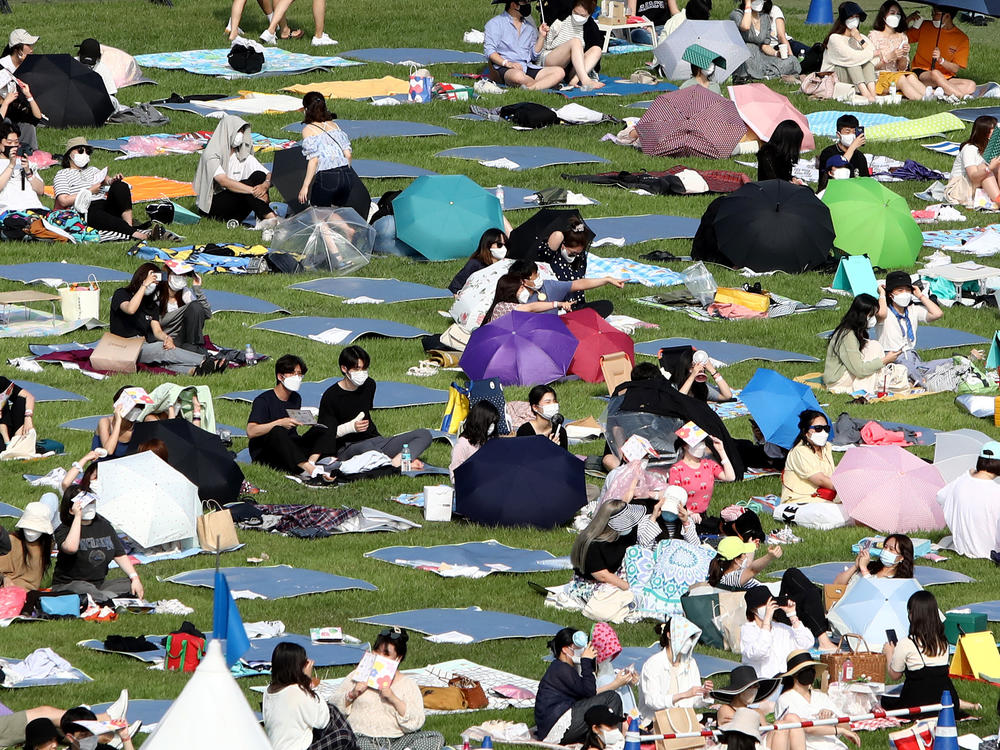Section Branding
Header Content
South Korea seeks a path to normal life from COVID-19
Primary Content
SEOUL — South Korea is seeking to recover some degree of normalcy after having fully vaccinated 70% of its population against COVID-19. Antivirus restrictions will be gradually eased, and for the first time in over a year, the scope of infection is not the primary deciding factor.
The country is still reeling from the wave of infection that peaked in September at 3,273 daily cases. The number has been hovering in recent weeks around 1,500 on the back of a fast-rising vaccination rate. South Korea's vaccinations got off to a slow start but have now surpassed the U.S.
But the country still has more to prepare for ahead of the new phase. Experts warn that it can entail unexpected developments.
The government announced on Friday that it will lift or soften limits on operation at most facilities, starting in November, while mandating proof of vaccination or negative PCR tests at some. Masks and spaced-out seating will stay in place.
Cafes and restaurants — indoors and outdoors — can remain open past 10 p.m., and gyms can reopen shower booths. Protests and weddings can take place with up to 499 vaccinated participants. Friends and families can gather inside and outside in groups of 10, up from the current 8 in the capital region. Vaccine passports will be required at clubs, pubs, karaoke bars, bathhouses, gyms and gambling houses.
Meanwhile, health authorities will expand home recovery of COVID-19 patients with mild or no symptoms, who were until recently all quarantined at government-run treatment centers. They will also expedite contact tracing with digital technology and simplified surveys that focus on higher-risk exposures.
The current approach is unsustainable and burdensome, the government and experts say
The long-awaited transition is what many here see as the beginning of an end of the pandemic in the country. But it is an "untraveled path," as Jeong Eun-kyeong, director of the Korea Disease Control Agency (KDCA), said this week, for a country that has consistently focused on, and largely succeeded in, suppressing the total number of cases.
That regime, supported by what experts are calling a robust 3T (test, trace, treat) strategy and extended social distancing restrictions, has become unsustainable, the government and experts say. It has incurred heavy social costs to small business owners, essential workers, students and caretakers, and the dominance of the delta variant increased the burden even more.
The new phase, officially named "gradual return to normal life," instead prioritizes keeping the number of deaths and severely-ill patients in control and protecting unvaccinated and high-risk groups.
Eased social distancing can "inevitably lead to somewhat higher case numbers," KDCA director Jeong admitted at a public hearing on Monday. "We have to find a way to safely coexist with COVID-19," she said, "even if that means taking some risks."
Some warn of higher case rates and hospitalizations as a result
In a panel discussion last week, Jung Jaehun, a professor of preventive medicine at Gachon University, said South Korea should be prepared by the first half of next year to accommodate 25,000 daily cases and 3,000 hospitalizations.
That prediction, based on one of three scenarios produced by mathematical modeling, is vastly different from the public's expectation. In a survey conducted in early October at Seoul National University's Graduate School of Public Health, 57.1% of respondents said the level of infection the South Korean society can endure after easing restrictions is 1,000 to 2,000 cases a day. Only 2.6% answered it can handle over 10,000 cases.
The same survey showed that 70.6% believe the meaning of daily case numbers is different now that the fatality rate has dropped and that 76.5% support transition to "coexistence of COVID-19 and normal life," even as outbreaks continue.
The gap between people's attitude and expectation is a result of insufficient risk communication from the government, according to Professor Yoo Hyun-jae, who leads Sogang University's Health Communication Center. "If numbers go up to thousands after the transition, people are likely to think differently," he said. "They will question the timing of the transition or whether it was the right thing to do."
Maintaining the right level of alarm is the key in risk communication, Yoo says, but the South Korean government's messages about the new phase have been "rose-tinted." Even the name "return" misleads many to think pre-COVID life is around the corner, he said, when many countries actually saw a surge in cases after transition.
"I think the government should tell citizens accurately about the risks they should face or endure, even if it's uncomfortable," Yoo said.
Copyright 2021 NPR. To see more, visit https://www.npr.org.

